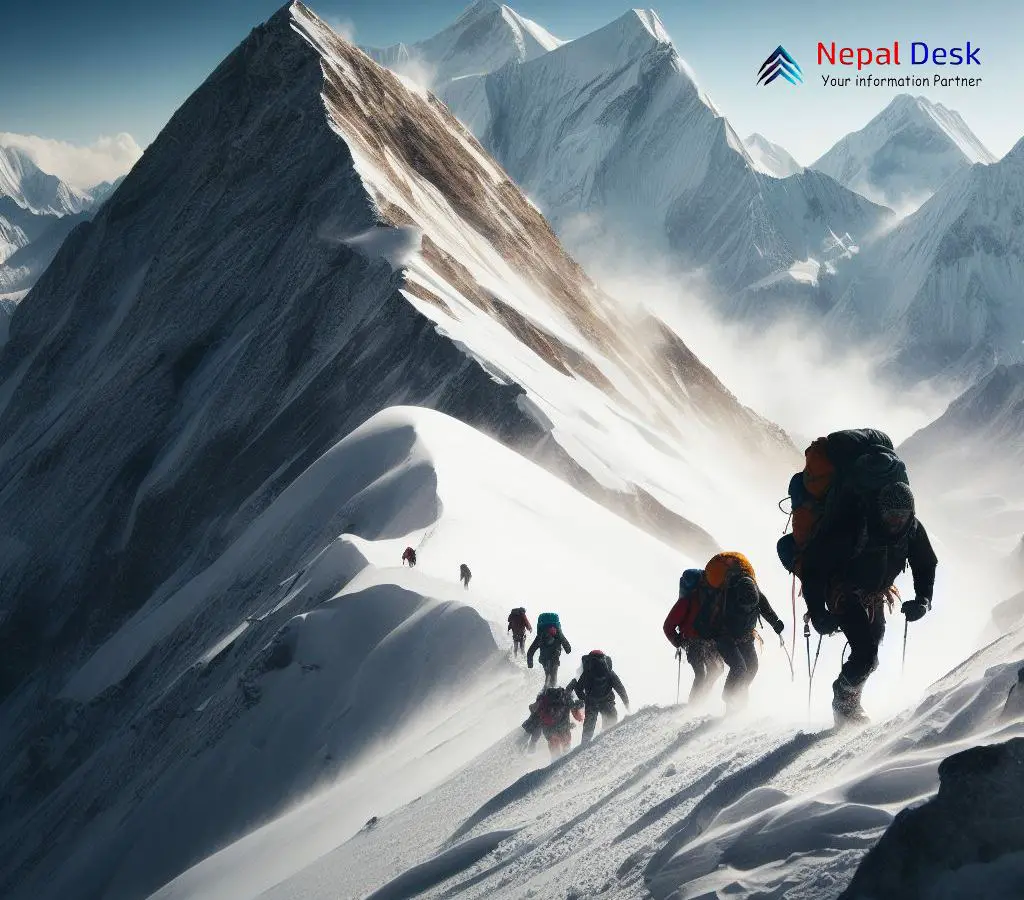Everest Route Changes After 10 Years; Know About Icefall Doctors
Published Date

Published Date
Learn about Mount Everest's route changes after 10 years; Also the role of Icefall Doctors in preparing the perilous Khumbu Icefall for climbers.
⏱ 4 min read
The route leading to Mount Everest, the world's highest peak, has undergone a significant change after a decade. Rakesh Gurung, the Director of the Tourism Department, revealed that for the spring season of 2024, a team of experienced climbers known as the 'Icefall Doctors' conducted experiments with a new route near 'Everest Camp One,' resulting in the creation of a successful path up to 'Everest Camp Two.' This development marks a departure from the previous route, with a distinct path being opened near 'Lho La Peak,' allowing the Icefall Doctors to ascend successfully beyond 'Camp One.'
The decision to reopen the route from a nearby location stems from previous unsuccessful attempts to navigate the unstable ice conditions of previous years. The Icefall Doctors, utilizing their expertise, managed to progress by establishing a new route. They explained that a specialized team dedicated to creating the path diligently monitored the ice conditions for a minimum of 15 days, conducting thorough risk analyses. Upon determining that the ice had stabilized sufficiently, they proceeded to open the new route and advance.
The Tourism Department anticipates that the team responsible for opening the route will reach the summit within approximately a week. Concurrently, the Sagarmatha Pollution Control Committee (SPCC) is actively involved in route creation at the 5,380-meter base camp of Mount Everest. The journey progresses through various camps, with the first camp situated at an altitude of 6,065 meters. Subsequent camps lead climbers closer to the summit. Currently, eight seasoned climbers are engaged in the route creation efforts.
Additionally, the tourism department has established a camp office at the base camp to manage expedition operations. Khimalal Gautam, an experienced climber who has previously summited Everest, assumes the role of chief at the base camp office. Director Gurung highlighted that the government team stationed at the base camp is tasked with regulating activities in and around Everest throughout the climbing season.
The latest statistics from the department indicate that 274 climbers across 26 teams have secured permits to climb Everest this year, including 53 women. These climbers hail from various nationalities, with 59 being American, 38 Chinese, 19 Japanese, 17 Indian, 16 Russian, and 15 British climbers obtaining climbing permits. In total, 612 members from 68 teams have acquired climbing permits for 23 expeditions scheduled for this year.
Icefall Doctors: Meaning, Roles and Other Facts
The Icefall Doctors are a group of highly skilled climbers, primarily Sherpas, who have a pivotal role in preparing the perilous Khumbu Icefall for climbers attempting to conquer Mount Everest. Let's delve into their significance and duties:
Key Role: The Khumbu Icefall is an ever-shifting maze of crevasses, towering seracs, and unstable terrain. Without a secure path through this hazardous zone, scaling Everest would be nearly insurmountable.
Preparation and Maintenance: The Icefall Doctors undertake tasks such as securing ropes, installing ladders over crevasses, and marking safe routes through the icefall before each climbing season. They essentially construct and sustain a crucial pathway for climbers aiming for the summit.
Expertise and Risk: These responsibilities demand exceptional expertise, years of experience navigating glaciers and ice formations, and a willingness to face substantial risks. The Icefall Doctors brave dangerous conditions and the potential threat of avalanches to ensure climbers have a relatively safe passage.
Selection and Training: Typically, the Icefall Doctors are seasoned Sherpas selected and compensated by the Sagarmatha Pollution Control Committee (SPCC), an official body overseeing waste management on Everest. Their training and selection may depend on the following areas:
- Experience: Icefall Doctors are seasoned climbers, primarily Sherpas, with extensive experience navigating glaciers and ice formations in the Everest region.
- Technical Skills: They are trained in technical climbing skills, including fixing ropes, installing ladders over crevasses, and identifying safe routes through the treacherous Khumbu Icefall.
- Risk Assessment: Icefall Doctors undergo thorough risk assessment training to evaluate ice stability, avalanche risks, and other hazards in the icefall.
- Teamwork: They learn effective teamwork and coordination, as their work involves collaboration with other Icefall Doctors and support teams.
- Equipment Handling: Training includes proficiency in handling specialized equipment like climbing gear, ropes, ladders, and safety devices.
- Environmental Awareness: Icefall Doctors are trained to be environmentally conscious, ensuring their work minimizes impact on the fragile ecosystem of the Everest region.
Despite their critical role, the Icefall Doctors often operate in anonymity among the general public. Nevertheless, they are regarded as heroes within the climbing community, recognized for their immense contribution to Everest expeditions.
In summary, the Icefall Doctors are an indispensable yet sometimes overlooked group whose efforts are instrumental in enabling the ascent of Mount Everest, showcasing their dedication and bravery in the face of extreme challenges.
